Cherry Red Records Stadium (Plough Lane)
| Capacity | 9 215 |
|---|---|
| 4,267 (West Stand) | |
| 1,092 (standing) (South Stand) | |
| 2,391 (East Stand) | |
| 1,465 (away section) (North Stand) | |
| Country | England |
| City | London |
| Clubs | AFC Wimbledon |
| Inauguration | 03/11/2020 |
| Design | KSS Group |
| Contractor | Buckingham Group |
| Construction | 16/03/2018 – 10/2020 |
| Cost | £ 33 million |
| Address | Plough Lane, London SW17 0NR, United Kingdom |
Advertisement
Plough Lane – stadium description
This stadium’s origin might be the most famous among so called ‘phoenix club’ stories. When Wimbledon FC relocated to Milton Keynes in 2003, supporters decided to stay put and rebuild their own club. Preserving identity was their short-term goal, while in the long term the dream was to return to Plough Lane, where the team’s historical stadium used to stand.
The old Plough Lane was in operation since 1912 but fell short of new safety and spectator comfort requirements after the Taylor Report. Since it was beyond saving, Wimbledon moved out in 1991, sharing Selhurst Park with Crystal Palace. The ground remained in limited use until 1998 and was eventually demolished in 2002. With residential buildings covering its area, it wasn’t an option to build on the very same spot, however land nearby became available.
In 2013, just over a decade since creation, AFC Wimbledon were able to announce partnership with developer Galliard Homes to take over land on which an old greyhound racing stadium was situated, just 200 metres east from the old ground, also on Plough Lane. For the developer such endeavour had to include vast residential development, which meant over 600 new apartments around the proposed new stadium, all packed on just 5.1 hectares.
After turbulent preparation and proceedings, planning permission was granted in 2017 and construction was due to begin in 2018. But, while the site was cleared entirely in that year and the residential part began growing, Wimbledon only took control of their site in December and actual work on the new stadium was launched in first half of 2019.
Funding for the sports development also proved problematic, despite a significant chunk being covered from the residential part and sale of Kingsmeadow. Supporters came to their club’s aid on more than one occasion, first through crowdfunding and then by buying bonds. In total, direct fan payments covered well over £7 million out of a total that ballooned to 33 million. Local businessman Nick Robertson also came to the club’s aid without sacrificing its democratic principles.
After over a year of construction, in autumn of 2020, opening became a possibility. But, because of the ongoing pandemic, fans were unable to attend the first match on November 3. The very first opportunity, albeit with restricted capacity, came on May 18, 2021, when 2,000 people enjoyed a friendly against Liverpool FC’s U23 team.
The delivered stadium is only the first phase of the final build. The west stand with its south-west corner are permanent, while three remaining stands and two floodlight masts are semi-permanent. They can (and eventually will) be dismantled to make way for much larger permanent structures. Such mode was chosen for economic and practical reasons. It’s simply much easier to grow within a smaller yet complete stadium.
The west side may have a single tier of seating, but together with two glazed levels above it comprises a total of 4 floors of facilities. This allowed AFC Wimbledon to deliver all necessary functions within the first phase, including sporting, administrative, media and hospitality areas. The remaining modular stands are lower but also fully functional. The south end is for the most vocal fans, with its safe standing section, the north end for away followers.
In its final layout, the stadium is expected to safely host up to 20,000 people with a compact bowl almost reaching the nearby residential building. Once delivered, it will make it impossible for neighbours to watch games from home.
How Plough Lane compares to other League One venues?
Advertisement
Pictures
-
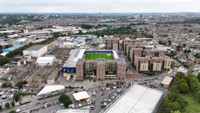
31.07.2025 © NEIL TIMOTHY 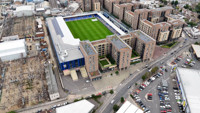
31.07.2025 © NEIL TIMOTHY 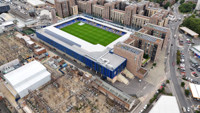
31.07.2025 © NEIL TIMOTHY 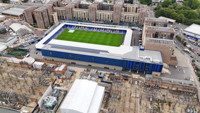
31.07.2025 © NEIL TIMOTHY 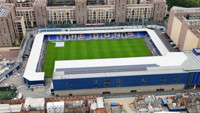
31.07.2025 © NEIL TIMOTHY 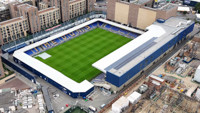
31.07.2025 © NEIL TIMOTHY 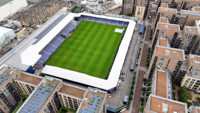
31.07.2025 © NEIL TIMOTHY 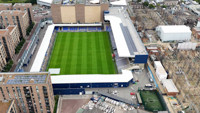
31.07.2025 © NEIL TIMOTHY 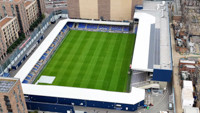
31.07.2025 © NEIL TIMOTHY 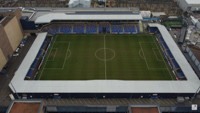
06.02.2024 © 92bydrone 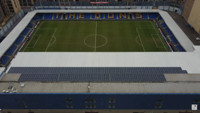
06.02.2024 © 92bydrone 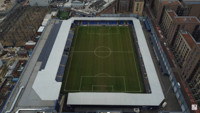
06.02.2024 © 92bydrone 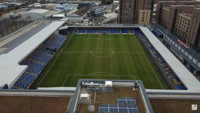
06.02.2024 © 92bydrone 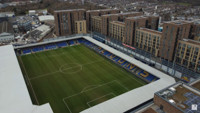
06.02.2024 © 92bydrone 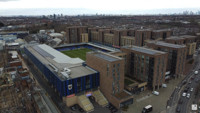
06.02.2024 © 92bydrone 
18.05.2021 © The Ball is Round 
18.05.2021 © The Ball is Round 
18.05.2021 © The Ball is Round 
18.05.2021 © The Ball is Round 
18.05.2021 © The Ball is Round 
18.05.2021 © The Ball is Round 
18.05.2021 © The Ball is Round 
18.05.2021 © The Ball is Round
Related news
2024
-
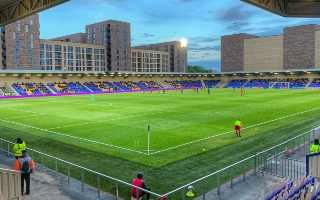
England: Flooding at AFC Wimbledon stadium was 'a matter of time'
The flooding that hit AFC Wimbledon's football stadium was "entirely predictable", according to local activists. Could ignoring warnings have contributed to the devastation the club is now facing?
-
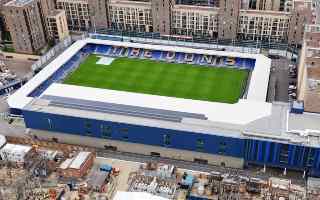
England: AFC Wimbledon’s new Plough Lane home embraced by local community
AFC Wimbledon, the phoenix club who have risen from the ashes of Wimbledon FC, have been on quite a journey since being forced to start again. After starting from the very bottom of the English football pyramid system, the Wombles achieved Football League status in 2002 in what many regard as the greatest story in football. Their return home to Plough Lane is also magical.

 StadiumDB
StadiumDB